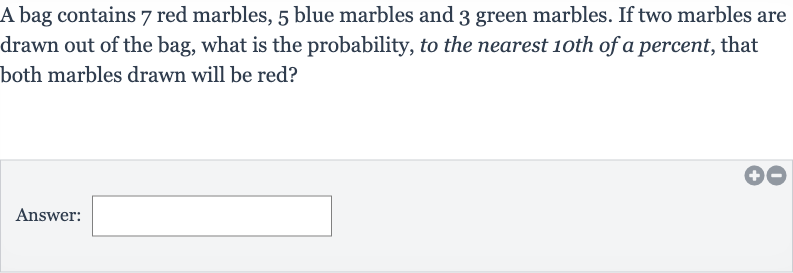AI tutor
Welcome to Bytelearn!
Let’s check out your problem:

A bag contains red marbles, blue marbles and green marbles. If two marbles are drawn out of the bag, what is the probability, to the nearest oth of a percent, that both marbles drawn will be red?Answer:
Full solution
Q. A bag contains red marbles, blue marbles and green marbles. If two marbles are drawn out of the bag, what is the probability, to the nearest oth of a percent, that both marbles drawn will be red?Answer:
- Calculate Total Marbles: First, we need to determine the total number of marbles in the bag.Total marbles Total marbles Total marbles
- Calculate Probability of First Red Marble: Next, we calculate the probability of drawing one red marble on the first draw.Probability of first red marble Probability of first red marble
- Update Marbles After First Draw: After drawing one red marble, there is one less red marble and one less total marble in the bag.New number of red marbles = Original number of red marbles New number of red marbles = New number of red marbles = New total number of marbles = Original total number of marbles New total number of marbles = New total number of marbles =
- Calculate Probability of Second Red Marble: Now, we calculate the probability of drawing a second red marble after the first one has been drawn.Probability of second red marble New number of red marbles New total number of marblesProbability of second red marble
- Multiply Probabilities for Both Red Marbles: To find the probability of both events happening (drawing two red marbles in a row), we multiply the probabilities of each individual event.Probability of both red marbles = Probability of first red marble Probability of second red marbleProbability of both red marbles = Probability of both red marbles = Probability of both red marbles =
- Simplify Probability Fraction: Simplify the fraction to find the probability in its simplest form. Probability of both red marbles = Probability of both red marbles =
- Convert Probability to Percentage: Finally, we convert the probability to a percentage to the nearest tenth of a percent.Probability as a percent = Probability of both red marbles Probability as a percent = Probability as a percent =
More problems from Percent error: word problems
QuestionGet tutor help
QuestionGet tutor help
QuestionGet tutor help
QuestionGet tutor help
QuestionGet tutor help
